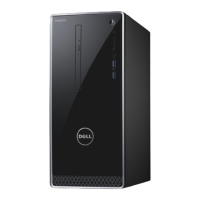● Automotive Connection System - New cables and connectors for automotive video systems, designed to meet the unique
demands of the motoring environment while delivering true HD quality
Advantages of HDMI
● Quality HDMI transfers uncompressed digital audio and video for the highest, crispest image quality.
● Low -cost HDMI provides the quality and functionality of a digital interface while also supporting uncompressed video
formats in a simple, cost-effective manner
● Audio HDMI supports multiple audio formats from standard stereo to multichannel surround sound
● HDMI combines video and multichannel audio into a single cable, eliminating the cost, complexity, and confusion of multiple
cables currently used in A/V systems
● HDMI supports communication between the video source (such as a DVD player) and the DTV, enabling new functionality
Memory features
In this computer, the memory (RAM) is a part of the system board. This computer supports a minimum of 2 GB and a maximum
of 32 GB memory, with the following features:
● 2400 MHz DDR4 for Vostro 3669 systems
● 2133 MHz DDR4 for Vostro 3660 systems
NOTE: If this computer is purchased with Intel 6th Generation CPUs or 7th Generation Celeron dual core CPU, the
maximum MHz this computer can achieve is 2133, though the memory material used is 2400 MHz.
Verifying system memory
Windows 10
1. Clickthe Windows button and select All Settings
> System .
2. Under System, click About.
Verifying system memory in setup
1. Turn on or restart your computer..
2. Perform one of the following actions after the Dell logo is displayed:
● BIOS — Tap F2 until theEntering BIOS setup message appears.
● Boot Menu — Tap F12 to enter the boot section menu.
3. On the left pane, select Settings > General > System Information,
The memory information is displayed on the right pane.
DDR4
DDR4 (double data rate fourth generation) memory is a higher-speed successor to the DDR2 and DDR3 technologies and
allows up to 512 GB in capacity, compared to the DDR3's maximum capacity of 128 GB per DIMM. DDR4 synchronous dynamic
random-access memory is keyed differently from both SDRAM and DDR to prevent the user from installing the wrong type of
memory into the system.
DDR4 needs 20 percent less or just 1.2 volts, compared to DDR3 which requires 1.5 volts of electrical power to operate. DDR4
also supports a new, deep power-down mode that allows the host device to go into standby without needing to refresh its
memory. Deep power-down mode is expected to reduce standby power consumption by 40 to 50 percent.
32
Technology and components

